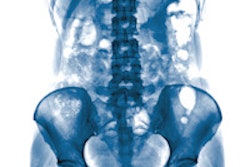
When it comes to reading bedside chest x-rays, is the radiologist still needed, or can the task be delegated to other physicians? Swiss researchers have found that as long as the person is experienced, the discipline really doesn't matter.
A retrospective study conducted at University Hospital Zurich compared bedside chest x-rays (i.e., anteroposterior chest x-rays) evaluated by five radiologists and five intensivists -- physicians who specialize in the care of intensive care unit (ICU) patients. The radiologists and intensivists ranged in experience level from residents (as little as one year of experience) to seniors (as much as 11 years of experience). The research team, led by Dr. Katharina Martini from the department of diagnostic and interventional radiology, found only resident intensivists could benefit from interdisciplinary dialogue.
"The results from our study show ... the agreement and accuracy in image interpretation between senior radiologists and senior intensivists was higher than in the correlating resident groups: Between the senior physicians of both specialties (radiologists vs. intensivists), no significant difference in the diagnostic accuracy was observed," Martini and colleagues wrote (Clinical Imaging, 22 July 2015).
Experience seems to be more of a factor in the accuracy of interpreting chest radiographs than the availability of clinical information, the authors hypothesized.
Study results
Critically ill patients are often admitted to the ICU in need of a chest x-ray. However, in smaller hospitals, a radiologist is not always available to evaluate the images immediately. In those cases, it is up to the intensivist to find the right diagnosis. How does the intensivist compare though? That's exactly what the researchers sought to find out.
Specifically, the radiologists and intensivists were asked to evaluate the presence and position of devices, as well as lung pathologies, in 33 patients. Devices included an endotracheal tube, central venous catheter, and tracheostomy tube. Pathologies included presence of pleural effusion, atelectasis, and infective consolidation. Chest CTs (Somatom Sensation, Siemens Healthcare) served as a standard of reference, which were evaluated in consensus by one senior intensivist and one senior radiologist.
The researchers found a high diagnostic accuracy for correct detection of endotracheal and tracheostomy tubes within all reading groups, whereas the central venous catheters were more often overlooked by all groups, except by the senior radiologists.
In all groups, more structures were identified as endotracheal tubes than were obviously installed.
| Diagnostic accuracy for detection of devices | |||
| Endotracheal tube | Tracheostomy tube | Central venous catheter | |
| Interobserver agreement | k = 0.984 (excellent) |
k = 0.939 (substantial to excellent) |
k = 0.727 (fair to substantial) |
Interobserver agreement was more homogenously distributed between the two radiology groups (range k = 0.727-1.0), while more scattered between the resident and senior intensivists (range k = 0.593-1.0).
Differences in diagnostic accuracy were statistically significant between radiology residents and senior radiologists and between resident intensivists and senior radiologists (p = 0.013 and 0.015, respectively) in evaluating central venous catheter malposition.
The detection of lung pathologies showed highest diagnostic accuracy in senior radiologists, whereas resident intensivists had the lowest diagnostic accuracy.
For the detection of lung atelectasis, the diagnostic accuracy was significantly lower for resident intensivists compared with all other groups (p ≤ 0.001). Concerning the diagnosis of infective consolidations, the accuracy was significantly lower in the group of resident intensivists compared with the group of senior radiologists (p = 0.04). Otherwise, no differences among the groups were found.
Experience is the factor
The results show residents tend to perform less well in detecting lung pathologies, such as infective consolidations and lung atelectasis, compared with senior physicians of both specialties, Martini and colleagues noted.
"Further, our results show that senior physicians of both specialties have a higher diagnostic accuracy and a more homogeneous distributed interobserver agreement," they added.
However, despite the differences in accuracy for evaluating bedside chest x-rays among the groups, the results showed generally no significant divergence in the diagnostic accuracy among all reader groups compared with chest CT, they emphasized.
Also, radiologists across the board were able to spot the incorrect position of devices; the same was not true among intensivists. A malpositioned device may not have the desired effect or, in the worst case, may harm the patient, so high diagnostic accuracy is a must, the authors noted.
"For the evaluation of the proper placement of devices, it is important to follow rules, providing an evaluated and standardized tool for decision-making," they wrote. "These rules are adopted for the image interpretation in our radiology department and are strictly taught during residency."
However, for residents at the ICU, the clinical status and adequate treatment of the patient is the primary focus in daily clinical routine.
"Systematic teaching of clinical guidelines and rules might play a more important role in the ICU than the interpretation of radiologic images," the authors concluded. "We presume that this provoked the poor consensus results in the ICU in comparison to the radiology department."
Owing to the study results, the researchers hypothesize the grade of experience is a more predictive factor in the accuracy of interpretation of chest radiographs than the availability of clinical information.



















